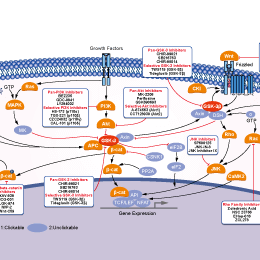
- 阻害剤
- 研究分野別
- PI3K/Akt/mTOR
- Epigenetics
- Methylation
- Immunology & Inflammation
- Protein Tyrosine Kinase
- Angiogenesis
- Apoptosis
- Autophagy
- ER stress & UPR
- JAK/STAT
- MAPK
- Cytoskeletal Signaling
- Cell Cycle
- TGF-beta/Smad
- 化合物ライブラリー
- Popular Compound Libraries
- Customize Library
- Clinical and FDA-approved Related
- Bioactive Compound Libraries
- Inhibitor Related
- Natural Product Related
- Metabolism Related
- Cell Death Related
- By Signaling Pathway
- By Disease
- Anti-infection and Antiviral Related
- Neuronal and Immunology Related
- Fragment and Covalent Related
- FDA-approved Drug Library
- FDA-approved & Passed Phase I Drug Library
- Preclinical/Clinical Compound Library
- Bioactive Compound Library-I
- Bioactive Compound Library-II
- Kinase Inhibitor Library
- Express-Pick Library
- Natural Product Library
- Human Endogenous Metabolite Compound Library
- Alkaloid Compound LibraryNew
- Angiogenesis Related compound Library
- Anti-Aging Compound Library
- Anti-alzheimer Disease Compound Library
- Antibiotics compound Library
- Anti-cancer Compound Library
- Anti-cancer Compound Library-Ⅱ
- Anti-cancer Metabolism Compound Library
- Anti-Cardiovascular Disease Compound Library
- Anti-diabetic Compound Library
- Anti-infection Compound Library
- Antioxidant Compound Library
- Anti-parasitic Compound Library
- Antiviral Compound Library
- Apoptosis Compound Library
- Autophagy Compound Library
- Calcium Channel Blocker LibraryNew
- Cambridge Cancer Compound Library
- Carbohydrate Metabolism Compound LibraryNew
- Cell Cycle compound library
- CNS-Penetrant Compound Library
- Covalent Inhibitor Library
- Cytokine Inhibitor LibraryNew
- Cytoskeletal Signaling Pathway Compound Library
- DNA Damage/DNA Repair compound Library
- Drug-like Compound Library
- Endoplasmic Reticulum Stress Compound Library
- Epigenetics Compound Library
- Exosome Secretion Related Compound LibraryNew
- FDA-approved Anticancer Drug LibraryNew
- Ferroptosis Compound Library
- Flavonoid Compound Library
- Fragment Library
- Glutamine Metabolism Compound Library
- Glycolysis Compound Library
- GPCR Compound Library
- Gut Microbial Metabolite Library
- HIF-1 Signaling Pathway Compound Library
- Highly Selective Inhibitor Library
- Histone modification compound library
- HTS Library for Drug Discovery
- Human Hormone Related Compound LibraryNew
- Human Transcription Factor Compound LibraryNew
- Immunology/Inflammation Compound Library
- Inhibitor Library
- Ion Channel Ligand Library
- JAK/STAT compound library
- Lipid Metabolism Compound LibraryNew
- Macrocyclic Compound Library
- MAPK Inhibitor Library
- Medicine Food Homology Compound Library
- Metabolism Compound Library
- Methylation Compound Library
- Mouse Metabolite Compound LibraryNew
- Natural Organic Compound Library
- Neuronal Signaling Compound Library
- NF-κB Signaling Compound Library
- Nucleoside Analogue Library
- Obesity Compound Library
- Oxidative Stress Compound LibraryNew
- Phenotypic Screening Library
- PI3K/Akt Inhibitor Library
- Protease Inhibitor Library
- Protein-protein Interaction Inhibitor Library
- Pyroptosis Compound Library
- Small Molecule Immuno-Oncology Compound Library
- Mitochondria-Targeted Compound LibraryNew
- Stem Cell Differentiation Compound LibraryNew
- Stem Cell Signaling Compound Library
- Natural Phenol Compound LibraryNew
- Natural Terpenoid Compound LibraryNew
- TGF-beta/Smad compound library
- Traditional Chinese Medicine Library
- Tyrosine Kinase Inhibitor Library
- Ubiquitination Compound Library
-
Cherry Picking
You can personalize your library with chemicals from within Selleck's inventory. Build the right library for your research endeavors by choosing from compounds in all of our available libraries.
Please contact us at info@selleck.co.jp to customize your library.
You could select:
- 抗体
- 新製品
- お問い合わせ
BIO
別名:GSK-3 Inhibitor IX, 6-bromoindirubin-3-oxime, 6-Bromoindirubin-3'-oxime, MLS 2052
BIO (GSK-3 Inhibitor IX, 6-bromoindirubin-3-oxime, 6-Bromoindirubin-3'-oxime, MLS 2052) is a specific inhibitor of GSK-3 with IC50 of 5 nM for GSK-3α/β in a cell-free assay, shows >16-fold selectivity over CDK5, also a pan-JAK inhibitor with IC50 of 30 nM for Tyk2. BIO induces apoptosis in human melanoma cells.
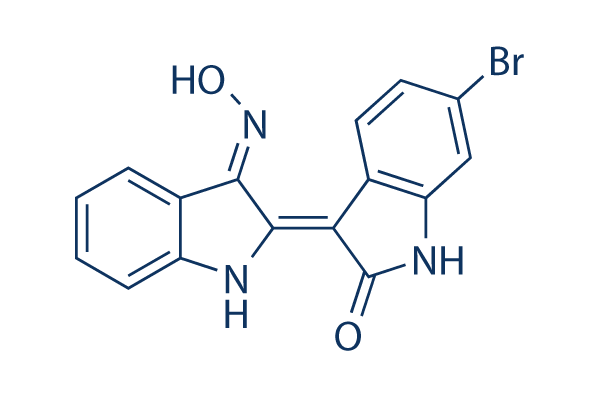
CAS No. 667463-62-9
文献中Selleckの製品使用例(40)
製品安全説明書
現在のバッチを見る:
S719803
DMSO]
71 mg/mL]
false]
Ethanol]
6 mg/mL]
false]
Water]
Insoluble]
false
純度:
99.9%
99.9
BIO関連製品
シグナル伝達経路
GSK-3阻害剤の選択性比較
Cell Data
| Cell Lines | Assay Type | Concentration | Incubation Time | 活性情報 | PMID |
|---|---|---|---|---|---|
| A549 | Function assay | 10 uM | 15 mins | Inhibition of human mPGES1 from human A549 cells assessed as PGE2 at 10 uM after 15 mins by HPLC | 24697244 |
| HT22 | Function assay | 10 uM | 24 hrs | Inhibition of GSK3-mediated beta casein phosphorylation in mouse HT22 cells at 10 uM after 24 hrs by Western blot analysis in presence of MG132 | 22998443 |
| HEK293 | Function assay | 0.5 to 1 uM | Inhibition of human GSK3 activity in HEK293 cells containing the Wnt/beta-catenin activated reporter pSuperTOPFLASH (STF293 cells) at 0.5 to 1 uM by Wnt reporter gene assay | 24697244 | |
| sf9 | Function assay | 1 uM | Inhibition of recombinant human N-terminal GST-tagged CDK4 (S4 to E303 residues)/Cyclin D1 (Q4 to I295 residues) expressed in sf9 cells at 1 uM using RB-CTF as substrate by filter binding assay | 28557430 | |
| sf9 | Function assay | 1 uM | Inhibition of human N-terminal GST/His6-tagged GSK3beta (M1 to T420 residues) expressed in baculovirus infected sf9 cells at 1 uM using RBER-IRStide as substrate by filter binding assay | 28557430 | |
| sf9 | Function assay | 1 uM | Inhibition of recombinant human N-terminal GST-tagged CDK2 (M1 to L298 residues)/Cyclin A2 (M1 to L432 residues) expressed in baculovirus infected sf9 cells at 1 uM using Histone H1 as substrate by filter binding assay | 28557430 | |
| sf9 | Function assay | 1 uM | Inhibition of recombinant human N-terminal GST-tagged CDK5 (M1 to P292 residues)/p35NCK (M1 to R307 residues) expressed in baculovirus infected sf9 cells at 1 uM using RB-CTF as substrate by filter binding assay | 28557430 | |
| sf9 | Function assay | 1 uM | Inhibition of human N-terminal GST/His6-tagged Aurora B (A2 to A344 residues) expressed in sf9 cells at 1 uM using tetra(LRRLSLG) as substrate by filter binding assay | 28557430 | |
| sf9 | Function assay | 1 uM | Inhibition of human N-terminal GST/His6-tagged FGFR1 (G400 to R820 residues) expressed in baculovirus infected sf9 cells at 1 uM using Poly(Glu,Tyr)4:1 as substrate by filter binding assay | 28557430 | |
| sf9 | Function assay | 1 uM | Inhibition of recombinant human N-terminal GST/His6-tagged CDK1 (M1 to M297 residues)/Cyclin B1 (M1 to V433 residues) expressed in sf9 cells at 1 uM using RB-CTF as substrate by filter binding assay | 28557430 | |
| sf9 | Function assay | 1 uM | Inhibition of recombinant human N-terminal GST-tagged CDK2 (M1 to L298 residues)/Cyclin E1 (M1 to A395 residues) expressed in sf9 cells at 1 uM using RB-CTF as substrate by filter binding assay | 28557430 | |
| sf9 | Function assay | 1 uM | Inhibition of human N-terminal GST/His6-tagged Aurora A (M1 to S403 residues) expressed in baculovirus infected sf9 cells at 1 uM using tetra(LRRLSLG) as substrate by filter binding assay | 28557430 | |
| sf9 | Function assay | 1 uM | Inhibition of human N-terminal GST-tagged Aurora B (M1 to S27 residues) expressed in sf9 cells at 1 uM using CDC25C-derived peptide as substrate by filter binding assay | 28557430 | |
| HuH7 | Antiproliferative assay | 72 hrs | Antiproliferative activity against human HuH7 cells after 72 hrs by MTT assay, IC50 = 6.2 μM. | 19783149 | |
| HL60 | Antiproliferative assay | 5 days | Antiproliferative activity against human HL60 cells after 5 days by MTT assay, IC50 = 5.4 μM. | 19783149 | |
| HepG2 | Cytotoxicity assay | 24 hrs | Cytotoxicity against human HepG2 cells assessed as cell growth inhibition after 24 hrs by alamar blue assay, IC50 = 5.3 μM. | 28743492 | |
| HCT116 | Antiproliferative assay | 72 hrs | Antiproliferative activity against human HCT116 cells after 72 hrs by MTT assay, IC50 = 5.2 μM. | 19783149 | |
| IMR90 | Antiproliferative assay | 72 hrs | Antiproliferative activity against human IMR90 cells after 72 hrs by MTT assay, IC50 = 1.9 μM. | 19783149 | |
| K562 | Antiproliferative assay | 72 hrs | Antiproliferative activity against human K562 cells after 72 hrs by MTT assay, IC50 = 1.3 μM. | 19783149 | |
| SH-SY5Y | Cytotoxicity assay | 48 hrs | Cytotoxicity against human SH-SY5Y cells after 48 hrs by MTS reduction assay, IC50 = 9 μM. | 18816110 | |
| SH-SY5Y | Function assay | 48 hrs | Survival of human SH-SY5Y cells after 48 hrs by MTS reduction assay, IC50 = 9.5 μM. | 16854069 | |
| SH-SY5Y | Function assay | 24 hrs | Survival of human SH-SY5Y cells after 24 hrs by MTS reduction assay, IC50 = 18 μM. | 16854069 | |
| IMR32 | Cytotoxicity assay | 48 hrs | Cytotoxicity against human IMR32 cells assessed as cell viability after 48 hrs by MTT assay | 21802947 | |
| SK-N-SH | Cytotoxicity assay | 48 hrs | Cytotoxicity against human SK-N-SH cells assessed as cell viability after 48 hrs by MTT assay | 21802947 | |
| NB39 | Cytotoxicity assay | 48 hrs | Cytotoxicity against human NB39 cells assessed as cell viability after 48 hrs by MTT assay | 21802947 | |
| SH-SY5Y | Function assay | Inhibition of GSK3-mediated beta-casein phosphorylation in human SH-SY5Y cells in presence of MG132 by Western blot analysis, IC50 = 0.29 μM. | 18816110 | ||
| HEI-OC1 | Function assay | Protection against cisplatin-induced cell death in neonatal mouse HEI-OC1 cells assessed as reduction in caspase-3/7 activity, EC50 = 0.192 μM. | 30091915 | ||
| SH-SY5Y | Function assay | Death of human SH-SY5Y cells in absence of 20 uM Q-VD-OPh by MTS reduction assay, IC50 = 10 μM. | 16854069 | ||
| SH-SY5Y | Function assay | Death of human SH-SY5Y cells in presence of 20 uM Q-VD-OPh by MTS reduction assay, IC50 = 13 μM. | 16854069 | ||
| A673 | qHTS assay | qHTS of pediatric cancer cell lines to identify multiple opportunities for drug repurposing: Primary screen for A673 cells | 29435139 | ||
| DAOY | qHTS assay | qHTS of pediatric cancer cell lines to identify multiple opportunities for drug repurposing: Primary screen for DAOY cells | 29435139 | ||
| Saos-2 | qHTS assay | qHTS of pediatric cancer cell lines to identify multiple opportunities for drug repurposing: Primary screen for Saos-2 cells | 29435139 | ||
| BT-37 | qHTS assay | qHTS of pediatric cancer cell lines to identify multiple opportunities for drug repurposing: Primary screen for BT-37 cells | 29435139 | ||
| RD | qHTS assay | qHTS of pediatric cancer cell lines to identify multiple opportunities for drug repurposing: Primary screen for RD cells | 29435139 | ||
| SK-N-SH | qHTS assay | qHTS of pediatric cancer cell lines to identify multiple opportunities for drug repurposing: Primary screen for SK-N-SH cells | 29435139 | ||
| BT-12 | qHTS assay | qHTS of pediatric cancer cell lines to identify multiple opportunities for drug repurposing: Primary screen for BT-12 cells | 29435139 | ||
| MG 63 (6-TG R) | qHTS assay | qHTS of pediatric cancer cell lines to identify multiple opportunities for drug repurposing: Primary screen for MG 63 (6-TG R) cells | 29435139 | ||
| NB1643 | qHTS assay | qHTS of pediatric cancer cell lines to identify multiple opportunities for drug repurposing: Primary screen for NB1643 cells | 29435139 | ||
| OHS-50 | qHTS assay | qHTS of pediatric cancer cell lines to identify multiple opportunities for drug repurposing: Primary screen for OHS-50 cells | 29435139 | ||
| Rh41 | qHTS assay | qHTS of pediatric cancer cell lines to identify multiple opportunities for drug repurposing: Primary screen for Rh41 cells | 29435139 | ||
| Rh30 | qHTS assay | qHTS of pediatric cancer cell lines to identify multiple opportunities for drug repurposing: Primary screen for Rh30 cells | 29435139 | ||
| SJ-GBM2 | qHTS assay | qHTS of pediatric cancer cell lines to identify multiple opportunities for drug repurposing: Primary screen for SJ-GBM2 cells | 29435139 | ||
| SK-N-MC | qHTS assay | qHTS of pediatric cancer cell lines to identify multiple opportunities for drug repurposing: Primary screen for SK-N-MC cells | 29435139 | ||
| NB-EBc1 | qHTS assay | qHTS of pediatric cancer cell lines to identify multiple opportunities for drug repurposing: Primary screen for NB-EBc1 cells | 29435139 | ||
| LAN-5 | qHTS assay | qHTS of pediatric cancer cell lines to identify multiple opportunities for drug repurposing: Primary screen for LAN-5 cells | 29435139 | ||
| Rh18 | qHTS assay | qHTS of pediatric cancer cell lines to identify multiple opportunities for drug repurposing: Primary screen for Rh18 cells | 29435139 | ||
| 他の多くの細胞株試験データをご覧になる場合はこちらをクリックして下さい | |||||
生物活性
| 製品説明 | BIO (GSK-3 Inhibitor IX, 6-bromoindirubin-3-oxime, 6-Bromoindirubin-3'-oxime, MLS 2052) is a specific inhibitor of GSK-3 with IC50 of 5 nM for GSK-3α/β in a cell-free assay, shows >16-fold selectivity over CDK5, also a pan-JAK inhibitor with IC50 of 30 nM for Tyk2. BIO induces apoptosis in human melanoma cells. | |||||||||||
|---|---|---|---|---|---|---|---|---|---|---|---|---|
| 特性 | The first pharmacological agent shown to maintain self-renewal in human and mouse embryonic stem cells. | |||||||||||
| Targets |
|
| In Vitro | ||||
| In vitro | BIO (6-bromoindirubin-3'-oxime) is a specific inhibitor of glycogen synthase kinase-3 (GSK-3), with IC50 of 5 nM for GSK-3α/β, shows >16-fold selectivity over CDK5. This compound interacts within the ATP binding pocket of these kinases, reduces β-catenin phosphorylation on a GSK-3-specific site in cellular models, closely mimicks Wnt signaling in Xenopus embryos. [1] In human and mouse embryonic stem cells, this chemical maintains the undifferentiated phenotype and sustains expression of the pluripotent state-specific transcription factors Oct-3/4, Rex-1 and Nanog. This compound-mediated Wnt activation is functionally reversible, as withdrawal of the compound leads to normal multidifferentiation programs in both human and mouse embryonic stem cells. [2] It promotes proliferation in mammalian cardiomyocytes. [3]6BIO is also a pan-JAK inhibitor, with IC50 values of 0.03, 1.5, 8.0, 0.5 μM for TYK2, JAK1, JAK2 and JAK3. This compound selectively inhibits phosphorylation of STAT3 and induces apoptosis of human melanoma cells. [4] | |||
|---|---|---|---|---|
| Kinase Assay | Kinase assay | |||
| Kinase activities are assayed in Buffer A or C at 30°C, at a final ATP concentration of 15 μM. Blank values are subtracted and activities calculated as pmoles of phosphate incorporated during a 10 min incubation. Controls are performed with appropriate dilutions of dimethylsulfoxide. In a few cases phosphorylation of the substrate is assessed by autoradiography after SDS-PAGE. GSK-3α/β is purified from porcine brain by affinity chromatography on immobilized axin. It is assayed, following a 1/100 dilution in 1 mg BSA/ml 10 mM DTT, with 5 μl 40 μM GS-1 peptide, a specific GSK-3 substrate, (YRRAAVPPSPSLSRHSSPHQSpEDEEE), in buffer A, in the presence of 15 μM [γ-32P] ATP (3,000 Ci/mmol; 1 mCi/ml) in a final volume of 30 μl. After 30 min incubation at 30°C, 25 μl aliquots of supernatant are spotted onto 2.5 × 3 cm pieces of Whatman P81 phosphocellulose paper, and 20 seconds later, the filters are washed five times (for at least 5 min each time) in a solution of 10 ml phosphoric acid/liter of water. The wet filters are counted in the presence of 1 ml ACS scintillation fluid. | ||||
| 細胞実験 | 細胞株 | COS1, Hepa or SH-SY5Y cells | ||
| 濃度 | ~10 μM | |||
| 反応時間 | 12 or 24 h | |||
| 実験の流れ | COS1, Hepa (wild-type, CEM/LM AhR deficient and ELB1 ARNT deficient), or SH-SY5Y cells are grown in 6 cm culture dishes in Dulbecco's Modified Medium (DMEM) containing 10% fetal bovine serum. For treatment, IO (5 μM), BIO (5 or 10 μM), MeBIO (5 or 50 μM), LiCl (20 or 40 mM), or mock solution (DMSO, 0.5% final concentration) is added to medium when cell density reaches ∼70% confluence. After 12 (SH-SY5Y) or 24 hours, the cells, while still in plate, are lysed with lysis buffer (1% SDS, 1 mM sodium orthovanadate, 10 mM Tris [pH 7.4]). The lysate is passed several times through a 26G needle, centrifuged at 10,000 × g for 5 min, and adjusted to equal protein concentration. About 8 μg of each sample is loaded for immunoblotting. Enhanced chemiluminescence is used for detection. The following primary antibodies are used: mouse anti-β-catenin CT (Upstate Biotechnolgies, Clone 7D8, recognizes total β-catenin), mouse anti-phospho-β-catenin (Upstate Biotechnologies, Clone 8E7, recognizes dephosphorylated β-catenin), mouse anti-GSK-3 β, mouse anti-GSK-3 phosphoTyr216, rabbit anti-AhR (Aryl hydrocarbon receptor), and rabbit anti-actin. | |||
| 実験結果図 | Methods | Biomarkers | 結果図 | PMID |
| Western blot | p-AKT / AKT / p21 / p27 p-β-catenin / β-catenin FoxO3a / FoxO1 / p-FoxO3a / p-FoxO1 |
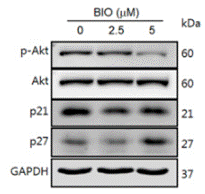
|
27510556 | |
| Immunofluorescence | pAKT / p21 / p27 TNF-α E-cadherin / Nanog Oct3/4 |
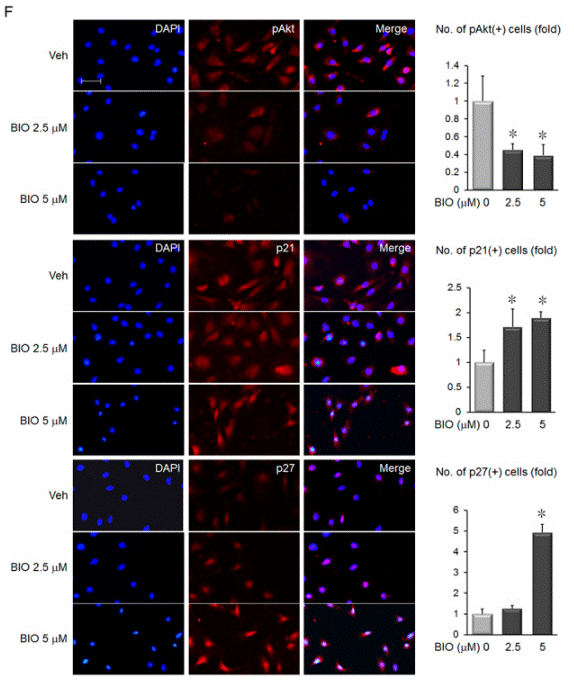
|
27510556 | |
| Growth inhibition assay | Cell proliferation |
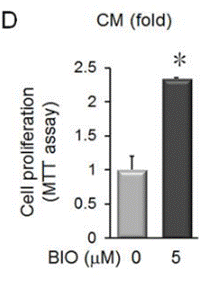
|
27510556 | |
| In Vivo | ||
| In Vivo | BIO suppresses melanoma tumor growth in a mouse xenograft model. [4] | |
|---|---|---|
| 動物実験 | 動物モデル | mouse |
| 投与量 | 50 mg/kg | |
| 投与経路 | Oral gavage | |
| NCT Number | Recruitment | Conditions | Sponsor/Collaborators | Start Date | Phases |
|---|---|---|---|---|---|
| NCT06337422 | Not yet recruiting | Healthy Volunteer |
International Bio service |
September 23 2024 | Phase 1 |
| NCT04276857 | Not yet recruiting | Locally Advanced Pancreatic Cancer|Irreversible Electroporation |
University of Saskatchewan |
September 1 2024 | Not Applicable |
| NCT06359041 | Not yet recruiting | Generalized Myasthenia Gravis (gMG) |
Cabaletta Bio |
August 2024 | Phase 1|Phase 2 |
|
化学情報
| 分子量 | 356.17 | 化学式 | C16H10BrN3O2 |
| CAS No. | 667463-62-9 | SDF | Download BIO SDFをダウンロードする |
| Smiles | C1=CC=C2C(=C1)C(=C(N2)C3=C(NC4=C3C=CC(=C4)Br)O)N=O | ||
| 保管 | |||
|
In vitro |
DMSO : 71 mg/mL ( (199.34 mM); 吸湿したDMSOは溶解度を減少させます。新しいDMSOをご使用ください。) Ethanol : 6 mg/mL Water : Insoluble |
モル濃度計算器 |
|
in vivo Add solvents to the product individually and in order. |
投与溶液組成計算機 | |||||
実験計算
投与溶液組成計算機(クリア溶液)
ステップ1:実験データを入力してください。(実験操作によるロスを考慮し、動物数を1匹分多くして計算・調製することを推奨します)
mg/kg
g
μL
匹
ステップ2:投与溶媒の組成を入力してください。(ロット毎に適した溶解組成が異なる場合があります。詳細については弊社までお問い合わせください)
% DMSO
%
% Tween 80
% ddH2O
%DMSO
%
計算結果:
投与溶媒濃度: mg/ml;
DMSOストック溶液調製方法: mg 試薬を μL DMSOに溶解する(濃度 mg/mL, 注:濃度が当該ロットのDMSO溶解度を超える場合はご連絡ください。 )
投与溶媒調製方法:Take μL DMSOストック溶液に μL PEG300,を加え、完全溶解後μL Tween 80,を加えて完全溶解させた後 μL ddH2O,を加え完全に溶解させます。
投与溶媒調製方法:μL DMSOストック溶液に μL Corn oil,を加え、完全溶解。
注意:1.ストック溶液に沈殿、混濁などがないことをご確認ください;
2.順番通りに溶剤を加えてください。次のステップに進む前に溶液に沈殿、混濁などがないことを確認してから加えてください。ボルテックス、ソニケーション、水浴加熱など物理的な方法で溶解を早めることは可能です。
技術サポート
ストックの作り方、阻害剤の保管方法、細胞実験や動物実験の際に注意すべき点など、製品を取扱う時に問い合わせが多かった質問に対しては取扱説明書でお答えしています。
他に質問がある場合は、お気軽にお問い合わせください。
* 必須

